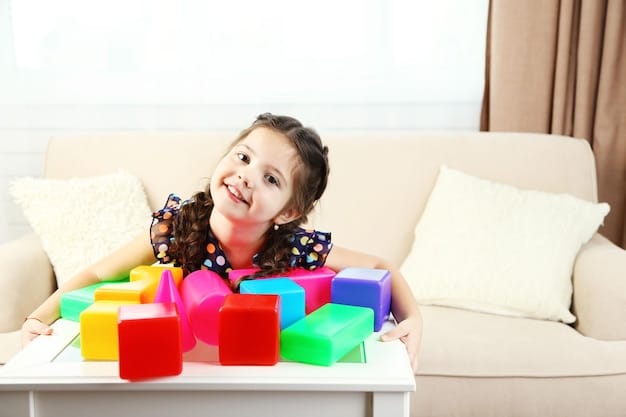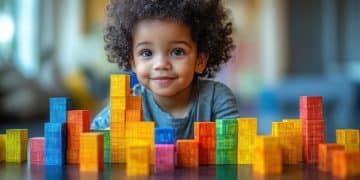The Role of Play in Cognitive Development: 10 Activities for Learning

Engaging in diverse play activities is crucial for fostering cognitive development in children, transforming abstract learning into tangible experiences that build critical thinking, problem-solving, and creativity from an early age.
For centuries, play has been at the heart of childhood, a seemingly simple activity that, upon closer inspection, reveals itself as a complex engine for growth. The notion that the role of play in cognitive development: 10 activities to boost your child’s learning is pivotal is not new, yet its profound impact is often underestimated in a world increasingly focused on structured academics. This article delves into how intentional, engaging play actively shapes a child’s brain, fostering crucial skills like problem-solving, creativity, and memory, and presents ten foundational activities designed to harness this potential, transforming everyday fun into powerful learning experiences.
The foundational links between play and cognitive development
Understanding the role of play in cognitive development begins with recognizing that children are not merely empty vessels waiting to be filled with knowledge; they are natural explorers and innovators. Play provides the crucial environment for this exploration, offering a safe space to experiment, make mistakes, and discover without the pressure of formal instruction.
This intrinsic link is supported by extensive research in psychology and neuroscience. When children engage in play, their brains are actively forming new neural connections, particularly in areas associated with executive functions like planning, working memory, and cognitive flexibility. This process is far more effective than passive learning, as play inherently involves active participation and intrinsic motivation. Through imaginative scenarios and problem-solving challenges presented within play, children develop abstract thought and symbolic representation—essential building blocks for advanced cognitive processes.
How play stimulates brain growth
The stimulation provided by play is multifaceted, engaging various brain regions simultaneously. For instance, playing with blocks demands spatial reasoning, while dramatic play cultivates language and social understanding. Each type of play activity contributes to a comprehensive developmental profile.
- Sensory Play: Engages the five senses, forming foundational neural pathways.
- Constructive Play: Develops spatial awareness, planning, and fine motor skills.
- Dramatic Play: Fosters language development, empathy, and social negotiation.
- Physical Play: Enhances coordination, balance, and the integration of sensory input.
These interconnected benefits mean that play is not just “fun”; it is indispensable work for a child’s developing mind. It’s an organic, self-directed form of education where lessons are absorbed naturally through engagement and enjoyment, laying a robust foundation for future academic and life successes. When children play, they are building the cognitive architecture necessary for complex thinking and lifelong learning.
Decoding cognitive development: key pillars benefiting from play
To fully grasp the significance of play, it’s essential to break down cognitive development into its core components and see how play directly impacts each one. Cognitive development encompasses how children think, explore, and figure things out, including the development of knowledge, skills, problem-solving, and dispositions, which help them to think about and understand the world around them. This intricate process is not linear but occurs through a dynamic interplay of experiences, with play serving as a primary catalyst.
Executive functions: the command center of the brain
One of the most critical areas bolstered by play is executive function. These are high-level cognitive skills that control and regulate other abilities and behaviors.
- Working Memory: During a game of ‘Simon Says,’ a child must remember a sequence of commands, directly exercising working memory.
- Inhibitory Control: Playing ‘Red Light, Green Light’ requires a child to stop on command, practicing impulse control.
- Cognitive Flexibility: Adapting rules in a make-believe game or finding new ways to use a toy fosters flexibility in thinking.
These abilities are crucial for academic success, self-regulation, and navigating social situations. Children with robust executive functions are typically better at focusing, following directions, and managing their emotions, skills fundamentally nurtured through engaging play.
Problem-solving and critical thinking through exploration
Play inherently presents children with problems to solve. Whether it’s figuring out how to balance blocks to prevent a tower from toppling or devising a strategy to win a board game, children are constantly engaged in critical thinking.
This type of learning is vastly more effective than being told solutions. When a child independently discovers how to overcome a challenge in play, they are not only learning a specific solution but internalizing the process of problem-solving itself. This active engagement builds resilience and a willingness to tackle new challenges, knowing they have the capacity to figure things out. It’s in these moments of self-directed discovery that true critical thinking skills are forged.
Beyond the academic: social-emotional and language benefits
While the focus on **the role of play in cognitive development: 10 activities to boost your child’s learning** often centers on academic-related skills, the holistic benefits extend far beyond. Play is a powerful vehicle for social-emotional growth and language acquisition, both of which are inextricably linked to a child’s overall cognitive well-being and ability to learn effectively in all contexts.
Cultivating emotional intelligence and social skills
Much of a child’s play involves interaction with others, whether siblings, friends, or caregivers. These interactions are fertile ground for developing emotional intelligence and crucial social skills. Through shared play, children learn:
- Empathy: Taking on different roles in dramatic play helps children understand perspectives beyond their own. Pretending to be a doctor caring for a patient, for example, allows them to feel what it’s like to be in a nurturing role and to understand the patient’s vulnerability.
- Negotiation and Cooperation: Deciding on game rules, sharing toys, or resolving conflicts over who gets to be the “leader” all require negotiation and cooperation. These moments teach children compromise and how to work as part of a team, essential for collaborative learning environments and future relationships.
- Self-Regulation: Managing frustration when a game doesn’t go their way, waiting for a turn, or adhering to rules all contribute to developing self-control and emotional regulation. Play provides immediate feedback on behavior, allowing children to learn cause and effect in a safe, low-stakes environment.
These social-emotional competencies are not merely “soft skills”; they are foundational to cognitive processing. A child who can regulate their emotions is better positioned to focus and engage in learning tasks. A child who understands social cues can navigate classroom dynamics more effectively.
Language development and communication mastery
The verbal and non-verbal exchanges that occur during play are invaluable for language development. From the earliest babbling during peek-a-boo to complex storytelling in imaginative games, play constantly challenges and expands a child’s linguistic abilities.
Dramatic play, in particular, stimulates a rich vocabulary and complex sentence structures as children embody characters and create elaborate narratives. Simple conversations during constructive play, like discussing where to place a block, build descriptive language. Even unstructured play where children invent their own games enhances their ability to articulate rules, express ideas, and listen actively. This constant practice refines their understanding and use of language, which is foundational for reading, writing, and all forms of academic communication.

10 activities to boost your child’s cognitive learning
Having discussed the profound importance of play, let’s transition to practical applications. Here are ten concrete activities designed to actively enhance a child’s cognitive development, blending fun with critical learning outcomes. These activities are easy to implement with common household items or readily available materials, making them accessible for all families keen on fostering their child’s intellectual growth.
1. Building with open-ended materials
Give children blocks, LEGOs, cardboard boxes, or even pillows and blankets. The key is “open-ended,” meaning these materials have no pre-determined purpose.
This activity dramatically enhances spatial reasoning, problem-solving, and engineering skills. As children design and construct, they are constantly testing hypotheses (e.g., “Will this tower be stable?”), adjusting plans, and learning about balance, gravity, and structural integrity. The creative freedom also boosts divergent thinking—the ability to generate multiple solutions to a problem.
2. Puzzles and shape sorters
From simple shape sorters for toddlers to complex jigsaw puzzles for older children, these activities are foundational for developing critical cognitive skills.
Puzzles require visual-spatial processing, fine motor skills, and logical reasoning. Children learn to recognize patterns, categorize, and solve problems through trial and error. The satisfaction of completing a puzzle also fosters persistence and resilience.
3. Storytelling and dramatic play
Encourage children to create their own stories, using puppets, dress-up clothes, or simply their imagination. Join in and follow their lead.
This type of play is a powerhouse for language development, creativity, and empathy. Children expand their vocabulary, practice narrative structure, and develop perspective-taking skills as they imagine themselves in different roles and scenarios. It also boosts memory as they remember plot points and character traits.
4. Board games and card games
Classic games like “Candyland,” “Chutes and Ladders,” checkers, or even simple matching card games offer structured learning opportunities.
These games teach turn-taking, rule-following, strategic thinking, and patience. They introduce concepts of probability, numbers, and logical sequencing. Winning and losing also provide valuable lessons in emotional regulation and sportsmanship.
5. Sensory bins and stations
Create bins filled with rice, beans, water, sand, or pasta, along with scoopers, small toys, and containers.
Sensory play stimulates multiple brain areas by engaging different senses. It enhances fine motor skills, encourages exploration, and can be deeply calming. Children learn concepts like volume, texture, and density through hands-on manipulation.
6. Simple science experiments
Activities like making slime, building a baking soda volcano, exploring floating and sinking objects, or observing plant growth.
These experiments introduce basic scientific principles, foster curiosity, and encourage hypothesis testing. Children learn about cause and effect, observation, and critical thinking as they try to understand “why” something happens.
7. Nature exploration and loose parts play
Take your child outdoors to explore nature – collect leaves, sticks, rocks. Indoors, provide “loose parts” like buttons, bottle caps, or pinecones.
Nature exploration boosts observation skills, categorizing, and environmental awareness. Loose parts encourage open-ended creativity and problem-solving, allowing children to invent their own games and constructions.
8. Art and creative expression
Provide a variety of art supplies: crayons, paint, clay, playdough, paper, fabric scraps. Focus on the process, not just the finished product.
Art activities enhance fine motor skills, color recognition, and imaginative thinking. Children learn to express themselves non-verbally, developing creativity and emotional outlets. The process of creation also boosts self-esteem and problem-solving as they work to bring their artistic vision to life.
9. Music and movement
Singing songs together, dancing freely, or playing simple instruments.
Music stimulates auditory processing, rhythm, and memory. Movement enhances coordination, balance, and spatial awareness. Both activities work together to integrate sensory and motor skills, boosting overall cognitive function and mood.
10. Cooking and baking together
Involve your child in simple cooking tasks like mixing ingredients, measuring, or stirring.
Cooking is a highly practical activity that incorporates a multitude of cognitive skills: following instructions, measuring (math concepts), sequencing, cause and effect (how ingredients change), and problem-solving if a recipe needs adjustment. It also enhances fine motor skills and fosters a sense of accomplishment.
Each of these activities, while seemingly simple, provides a rich environment for children to develop robust cognitive skills, preparing them not just for school, but for a lifetime of learning and adaptation. The key is to embrace play as a fundamental learning tool, allowing children the freedom to explore, experiment, and discover at their own pace.
Integrating play into daily routines without added pressure
The concept of integrating play into daily life can sometimes feel like another item on an already overwhelming to-do list for parents. However, the true **role of play in cognitive development: 10 activities to boost your child’s learning** lies not in adding more structured tasks, but in consciously reframing everyday moments as opportunities for playful learning. The goal is to weave play seamlessly into existing routines, fostering cognitive growth without creating undue pressure for either the child or the caregiver.
This approach emphasizes quality over quantity, focusing on engaging interactions rather than rigid schedules. For instance, a simple trip to the grocery store can become a game of “I Spy” (visual perception, attention) or a counting exercise (“How many apples are in the basket?”). Bath time can transform into a water exploration lab, experimenting with floating and sinking (basic physics, problem-solving). The journey to and from school can be an opportunity for storytelling, where each person adds a sentence (narrative skills, language development).
Creating unstructured play opportunities
Perhaps the most valuable gift parents can offer for cognitive development is unstructured playtime. This is time when children lead their own play, without adult direction or interference. It is during these moments that creativity truly flourishes, problem-solving becomes organic, and self-regulation skills are honed as children navigate their own play scenarios.
Parents can facilitate unstructured play by:
- Providing open-ended materials: As discussed, toys that can be used in multiple ways (blocks, art supplies, natural materials) are more conducive to imaginative play than highly specialized toys.
- Designating a “play zone”: A dedicated space, even if small, where children can leave out ongoing projects encourages deeper engagement and minimizes cleanup stress.
- Stepping back: Resist the urge to direct or intervene unless absolutely necessary. Observe your child’s play, appreciate their autonomy, and be available if they seek interaction, but allow them the freedom to create their own play world.
This philosophy acknowledges that children learn best when they are intrinsically motivated and can follow their own curiosity. By providing the environment and the freedom, parents empower children to become active participants in their cognitive development, making learning an enjoyable and self-driven process. The subtle art lies in recognizing that play isn’t a break from learning; it is, in fact, the most effective mode of learning for young minds.

Common pitfalls and how to avoid them
While the benefits of play for cognitive development are clear, there are common pitfalls that can inadvertently diminish its effectiveness. Understanding these potential traps allows parents and educators to create truly enriching play environments. Navigating these challenges ensures that the **role of play in cognitive development: 10 activities to boost your child’s learning** remains impactful and genuinely beneficial.
Over-scheduling and over-directing play
One of the most frequent mistakes is over-scheduling a child’s day with structured activities, leaving little room for genuine, self-directed play. When every moment is planned, children lose the opportunity to choose, imagine, and manage their own time – all crucial for developing executive functions. Similarly, well-intentioned adults might over-direct play, telling children exactly what to do or how to play with a toy.
To avoid this, aim for balance. Ensure there are significant blocks of unstructured time each day. When children are playing, observe more than you interfere. Offer materials, but let them decide how to use them. Resist the urge to “correct” their play or suggest new activities unless they explicitly ask for help or seem truly stuck.
Over-reliance on screen time
While digital tools can offer some educational benefits, excessive or passive screen time can displace more active, hands-on, and socially interactive forms of play that are vital for cognitive development. Screen time, particularly when it’s non-interactive, often provides passive consumption rather than active creation and problem-solving.
Encourage a healthy balance. Set clear limits for screen time and prioritize interactive play. Encourage apps and games that require active thinking, problem-solving, and creativity rather than passive viewing. Crucially, engage with your child during screen time when possible, turning it into a shared learning experience rather than isolated consumption.
Underestimating the power of simple, everyday play
In a world filled with sophisticated educational toys and programs, it’s easy to overlook the profound impact of simple, everyday play. Sometimes, parents feel pressure to constantly buy the latest “brain-boosting” gadgets.
Remember that often, the simplest materials (cardboard boxes, blankets, sticks, water) are the most powerful for fostering imagination and problem-solving because they require the child to supply the creativity. Focus on providing diverse, open-ended materials and the freedom to explore them, rather than solely relying on commercially marketed “educational” toys. The most effective play is often child-led, resource-modest, and rich in natural discovery. By being mindful of these common issues, parents can ensure that play remains a powerful, positive force in their child’s cognitive journey.
| Key Contribution | Cognitive Benefit |
|---|---|
| 🧠 Executive Functions | Enhances working memory, inhibitory control, and cognitive flexibility. |
| 💡 Problem-Solving | Develops critical thinking and ability to find solutions through exploration. |
| 🗣️ Language & Social | Fosters communication skills, empathy, and emotional intelligence. |
| 🎨 Creativity & Innovation | Stimulates imagination and divergent thinking. |
Frequently Asked Questions About Play and Cognitive Development
Cognitive development refers to the process by which children acquire knowledge, skills, and problem-solving abilities. It involves understanding the world around them, processing information, and learning how to reason, think creatively, and remember. Play is a primary mode through which these crucial mental capabilities are honed and refined from infancy through adolescence.
Unstructured play, where children lead their own activities without adult direction, is invaluable for developing executive functions like planning, working memory, and cognitive flexibility. It fosters creativity, independent problem-solving, and decision-making skills. This freedom allows children to explore their interests, manage their own time, and build resilience by navigating self-created challenges.
Not necessarily. While some educational toys can be beneficial, open-ended materials like blocks, art supplies, or natural elements (sticks, leaves) often provide more robust cognitive benefits. These materials encourage imagination, versatile problem-solving, and creative exploration, as children must define their own play and purposes for them, rather than following pre-determined rules.
Parents can encourage play by providing plenty of unstructured time, offering a variety of open-ended play materials, and creating a safe, stimulating environment. Critically, stepping back and allowing children to lead their own play, without excessive direction or interference, is key. Joining in when invited, but primarily observing, empowers children to develop their own cognitive paths.
Play directly strengthens executive functions, which are vital skills for self-regulation and goal-directed behavior. Games that require turn-taking, rule-following, or strategic planning, such as board games or imaginative play where roles are assigned, enhance inhibitory control, working memory, and cognitive flexibility. These skills are fundamental for academic success and life management.
Unlocking lifelong learning through joyful engagement
In conclusion, the seemingly simple act of play holds immense power in shaping a child’s cognitive future. Far from being mere recreation, it is the fundamental mechanism through which children explore, experiment, and internalize complex concepts, laying down the neural pathways essential for lifelong learning. By embracing the role of play in cognitive development: 10 activities to boost your child’s learning, we acknowledge that true education is not solely about structured lessons, but about fostering an environment where curiosity thrives, problem-solving becomes intuitive, and creativity is celebrated. The activities outlined, from building with blocks to creating stories, are not just fun pastimes; they are intentional engagements that build executive functions, language skills, and social-emotional intelligence. By consciously integrating purposeful play into daily routines and resisting common pitfalls like over-scheduling, we empower children to become resilient, adaptable, and joyful learners. Ultimately, investing in play is investing in the holistic development of our children, equipping them not just with knowledge, but with the innate ability to learn, adapt, and innovate throughout their lives.





